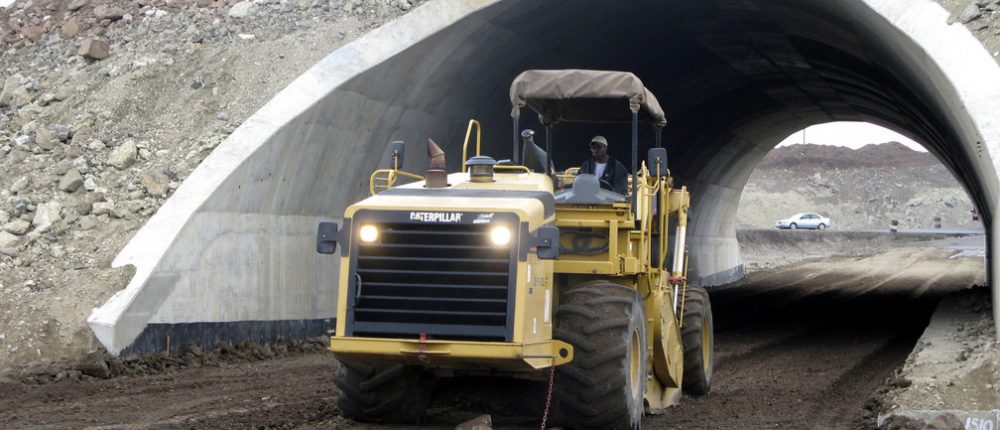How to tell which infrastructure projects will work

|
| Workers level the earth on the Mombasa-Nairobi highway construction project in Athi River, 20 km (12 miles) from Nairobi. REUTERS/Elizabeth Nganga. |
It’s the classic conundrum that governments typically grapple with – which projects are most beneficial in the long-term? How do large, expensive projects impact on the debt dynamics and macroeconomic stability?
While there is a need for large infrastructure investment in the developing world, it is often difficult for governments to determine the most beneficial projects.
Typically, the tools used to evaluate projects differ within governments. Moreover, current models are often complicated, time-consuming and do not take into account the localised impacts of specific projects, or fail to assess the full impact on the economy.
As the appetite for large infrastructure projects rises in developing countries, the demand for an adequate user-friendly model is likely to rise.
With this in mind, and in response to a request from the Nigerian authorities, the Niger Macroeconomic and Fiscal Team developed a simplified model that assessed the impact of a specific project on the economy. The model was designed to estimate the impact of this investment project on a discrete set of macroeconomic variables, such as trade, growth, inflation and debt.
To do this, it was explicitly developed to take into account the increase in demand that occurred during the project’s implementation, as well as the estimated impact of the project’s anticipated returns on the economy. The model helps better understanding how the execution of investment projects affect debt sustainability, as debt sustainability analyses often overlook the economic impact of funds borrowed and overly focus on their financial terms.
As a test case, we used the Kandadji Dam project in Niger to simulate the macroeconomic impact of a large infrastructure project. With a fairly large project cost – estimated at $785 million or around 10% of Niger’s gross domestic product (GDP) in 2013 – it was vital to estimate the net impact the project would have on Niger’s economy.
Interestingly, we found that the revenues generated by the project would add 0.45% to the GDP and the increased demand for domestic production during the construction phase of the project would increase the country’s GDP by 0.25% above the current projection.
The model also revealed that certain sectors such as construction and transportation would benefit from the increased demand during the construction phase and once operational, the dam would primarily boost agricultural output and electricity generation.
Throughout the project’s implementation phase there would be a marked increase in imports, which would adversely affect the balance of payments. However, upon completion of the project there would be a beneficial shift in terms of trade, with imports falling back to normal levels coupled with a boost to exports.
The impact of the project on debt dynamics and macroeconomic stability was also assessed. While the costs for the programme are significant, since a large proportion of financing is concessional the model estimated there would be limited effect on the fiscal deficit and debt burden for the government.
The aim of the Niger Macroeconomic and Fiscal Team is that the model will enable governments to obtain a long-term view on the macroeconomic impacts before they undertake large infrastructure projects so that they are able to make informed choices. With minimal customisation, the model can be used to assess projects or programmes across various sectors and it can also be replicated across countries.
[edit] Further information
For more information on the computational aspects of the model, please see Modeling the Impact of Large Infrastructure Projects: A Case Study from Niger.
[edit] About this article
This article was previously published on the Future of Construction Knowledge Sharing Platform and the WEF Agenda Blog. It was provided by the Niger Macroeconomic and Fiscal Team which works on improving the quality of public investment management and efficiency in Niger, taking into account the country’s budgetary resources, weak private sector, and fiscal management challenges.
The team:
- Olivier Beguy is an economist based in Chad.
- Sebastien C. Dessus is the programme leader based in Washington, DC.
- Abdoulahi Garba is an economist based in Niger.
- Hayman Jason is an economist and consultant.
- Johannes Herderschee is a senior economist, based in Washington, DC.
--Future of Construction 14:55, 16 Jun 2017 (BST)
[edit] Related articles on Designing Buildings Wiki
- 3 ways the world’s fastest growing economies can close the infrastructure gap.
- Advancing the outcome of challenging infrastructure projects through project alliancing.
- Global Construction 2025.
- India needs to build more infrastructure fast. Here’s how.
- Megaprojects.
- State of the construction industry in Uganda.
- These giant infrastructure projects are set to reshape Africa.
Featured articles and news
RTPI leader to become new CIOB Chief Executive Officer
Dr Victoria Hills MRTPI, FICE to take over after Caroline Gumble’s departure.
Social and affordable housing, a long term plan for delivery
The “Delivering a Decade of Renewal for Social and Affordable Housing” strategy sets out future path.
A change to adoptive architecture
Effects of global weather warming on architectural detailing, material choice and human interaction.
The proposed publicly owned and backed subsidiary of Homes England, to facilitate new homes.
How big is the problem and what can we do to mitigate the effects?
Overheating guidance and tools for building designers
A number of cool guides to help with the heat.
The UK's Modern Industrial Strategy: A 10 year plan
Previous consultation criticism, current key elements and general support with some persisting reservations.
Building Safety Regulator reforms
New roles, new staff and a new fast track service pave the way for a single construction regulator.
Architectural Technologist CPDs and Communications
CIAT CPD… and how you can do it!
Cooling centres and cool spaces
Managing extreme heat in cities by directing the public to places for heat stress relief and water sources.
Winter gardens: A brief history and warm variations
Extending the season with glass in different forms and terms.
Restoring Great Yarmouth's Winter Gardens
Transforming one of the least sustainable constructions imaginable.
Construction Skills Mission Board launch sector drive
Newly formed government and industry collaboration set strategy for recruiting an additional 100,000 construction workers a year.
New Architects Code comes into effect in September 2025
ARB Architects Code of Conduct and Practice available with ongoing consultation regarding guidance.
Welsh Skills Body (Medr) launches ambitious plan
The new skills body brings together funding and regulation of tertiary education and research for the devolved nation.
Paul Gandy FCIOB announced as next CIOB President
Former Tilbury Douglas CEO takes helm.
UK Infrastructure: A 10 Year Strategy. In brief with reactions
With the National Infrastructure and Service Transformation Authority (NISTA).























